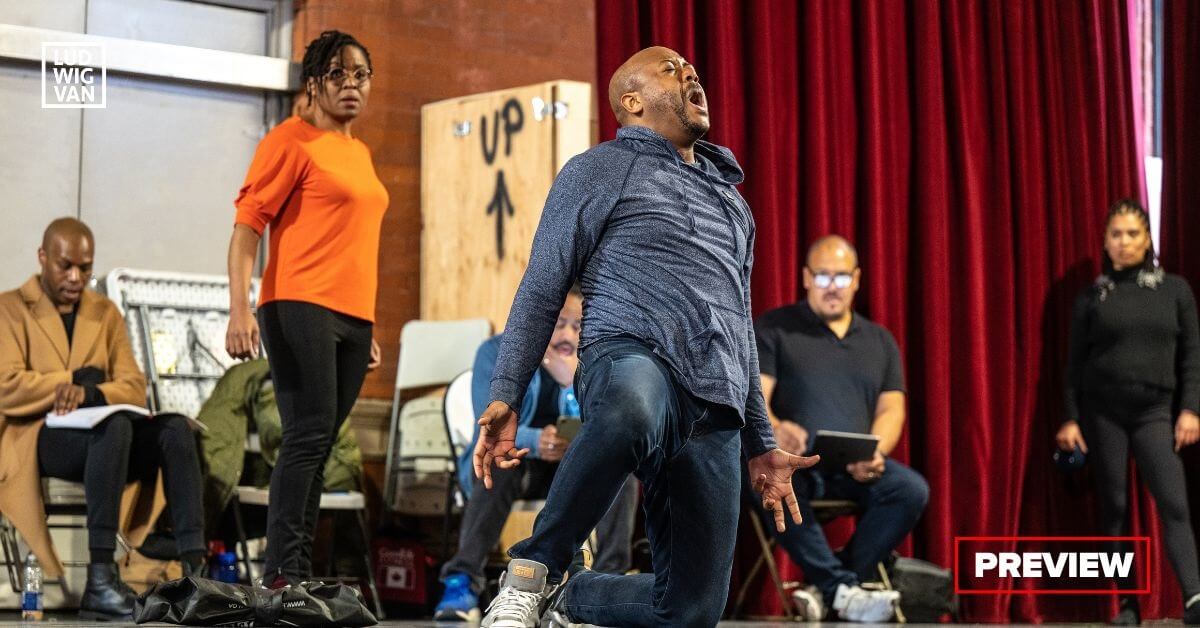
Six characters. A seven-member chorus. 19-members of the Canadian Opera Company Orchestra.
By any measure, these are the forces of a large-scale opera, but what is making history, however, is the fact that all the singers are Black. Joining them on the creative side are a Black librettist, director, movement director, and set and costume designer. In short, this is a Black opera.
The occasion is the world premiere of Of the Sea, presented by Obsidian Theatre and Tapestry Opera in partnership with TO Live, which opens this Saturday, March 25 at the Bluma Appel Theatre. Obsidian is Canada’s premiere Black theatre company, while Tapestry is the font of new Canadian opera.
What follows are details about Of the Sea gleaned from conversations with librettist Kanika Ambrose, composer Ian Cusson, and director Philip Akin.
All three are shining talents. Ambrose scored big this season with her harrowing play, our place, set in the Toronto Caribbean community. Cusson, who is of Métis and French-Canadian descent, had a successful run of his opera for young adults, Fantasma, presented by the COC in 2022. And what more can you say about director Philip Akin, except that he is a legend, a beloved artist who has graced the Canadian theatre community for almost 50 years.
Here’s what you need to know about Of the Sea.
The Black Mythology Behind Of the Sea
Among the captured Africans who survived the crossing of the Middle Passage, only to become slaves in the Caribbean and the Americas, an overpowering belief began to develop.
During those wretched crossings, they witnessed their dead and dying colleagues being thrown overboard, along with any troublemakers. The slaves began to believe that those lost Africans lived in cities beneath the ocean, and it was their anger and rage that caused the Atlantic storms.
Of the Sea’s Libretto
In the story that Ambrose has created, this Black myth takes on epic proportions.
Maduka (baritone Jorell Williams) has been thrown overboard for resisting authority by starving himself, and he has taken his six-month-old daughter Binyelum with him (voiced by soprano Ruthie Nkut). His belief is that he is saving his daughter from slavery.
The opera follows Maduka’s journey beneath the sea, where he meets two queens who have very contrasting beliefs about life. Serwa (soprano Chantale Nurse) is vengeful, while Dfiza (soprano Suzanne Taffot) has created a calm and ordered world. Two ancillary characters are Yaakaar (tenor Paul Williamson) who is Dfiza’s attendant and a musician, and Izunna (baritone Justin Welsh), a wanderer who befriends Maduka.
At the heart of the opera is Maduka’s over-powering and desperate love for his daughter, propelled by his regret for dragging her down with him. He wants to rescue her — to get to the surface to give her a beautiful life, even though it is against all odds. The revenge-seeking Maduka also obstinately clings to his god (the sun god) and his own value system, in the face of the forces ranged against him.
“Maduka’s story is one of hubris, where he struggles forward in the face of impending doom,” says Ambrose.
Cusson adds, “The competing goals of the two queens, one seeking revenge, and one seeking happiness, form the perfect landscape for conflict, as we watch how the fates unfold.”

Creating Of the Sea
Ambrose and Cusson met when they were thrown together in a Tapestry lib-lab in 2018, and found an instant rapport. Their resulting 10-minute Opera Brief excited immediate attention, and led to the commission of a full-length opera.
The lib-lab coincided with Ambrose’s desire to become a mother (which she ultimately did), and which anchored her beginning focus on a parent/child relationship. Cusson describes that short libretto as snapshots of character with hints of an epic story within.
From Ambrose’s point of view, it was hard to be creative because the story was too rooted in reality. What took Of the Sea to a mythological level was a suggestion by Tapestry’s executive director Jaime Martino. “She told me that I should open up the mythological elements,” explains Ambrose, “and that freed me to use my imagination. I could now use real African religions while creating my own theology as well.”
It was important for Ambrose, and the arc of the story, that Maduka take a while to find his course of action, namely revenge. Says Ambrose, “I realized that these waterworlds could be more than monolithic, and that’s why I introduced different philosophies for these cities under the sea, so that Maduka could explore different belief systems in the afterlife.”
The two queens came into being to present a strong female presence to counteract the male lead. And because Maduka needed a friend, the character of Izunna was created.
Akin, who attended the Opera Briefs performance in support of his sometime protégé Ambrose, admits he came with little expectation, but found himself caught up in the opera.
Says Akin, “Kanika had an interesting take on the myth. Her focus was on one man fighting against the system, trying to go back to the life he had before in order to save his daughter. He’s looking for people to help get him to the surface, and so comes in contact with different philosophies of belief. He absolutely is not accepting of his present reality, and the result is a powerful story.”
The Music
Right off the top, Ambrose says of Cusson, “Ian’s gorgeous music opened up all kinds of possibilities for me.”
Cusson returns the compliment by saying that Ambrose’s libretto was his inspiration. “The roadmap to the opera were her words,” he explains. Because of their instant rapport, the two were able to easily negotiate back and forth in the creation process.
Cusson describes Of the Sea as through-composed, with various arias and ensembles within the structure as a whole, rather than having set numbers. “Like Puccini,” he adds. The music is also built around themes, with each character having their own motif.
Also imbedded in the music is what Cusson calls “a sense of water” like the evoking of wave-like sounds. “The orchestrations also express psychology,” he says, “both spoken and unspoken, both complimentary and contrary.”
Akin seems to suggest that Cusson is a neo-Romantic. “There are singspiel elements,” he says, “but there is also a surprising amount of lovely melodies, so there is not much dissonance, which seems to go against the grain of new music.”
There is, however, a thorn in the rose, so to speak, as there were some people in the Black community who objected to the fact that composer Cusson is not Black.
Akin, however, fights back against this rubric. “The issue is not social justice; the issue is, can the dude write the music? Ian and Kanika had an instant creative rapport, and Ian doesn’t need melanin for that. Rapport is everything.”
What does Of The Sea Mean for the Black Community
Ambrose, Cusson and Akin — in fact, everyone connected with Of the Sea — are hoping to bring in a Black audience, and introduce them to opera. They also want to encourage young Black singers to study opera.
The major take-away from Of the Sea, however, is that a Black audience can see themselves, and their stories, represented on stage, because there is, quite frankly, little of that. Black opera singers are usually portraying Europeans of some sort, appearing in works by mostly European White men. In fact, it took the Metropolitan Opera 138 years to produce its first Black opera, with Terence Blanchard/Kasi Lemmons’ Fire Up in My Bones, in 2021.
In terms of Canadian Black opera, there has been Nicole Brooks’ Obeah Opera (2015/2019), with a reimagining of Scott Joplin’s Treemonisha coming up in the Luminato Festival in June. There is also the recent Haitian-influenced chamber opera, La Flambeau, by David Bontemps and Faubert Bolivar, that premiered in Montreal last month.
In other words, a large-scale Black opera like Of the Sea, is a gigantic leap forward in terms of Canadian opera canon, with the potential to be a real game-changer in regard to attracting a Black audience.
Final Words From Director Akin
Akin may have 46 years of experience in the theatre, but Of the Sea is only his second opera. His first stint at directing opera was the very daring Brian Barrett/Liza Balkan opus, Gould’s Wall, jointly presented by Tapestry and the Royal Conservatory in 2022.
He regards Of the Sea as a learning experience as he deepens his knowledge of opera. “And I do enjoy the process of learning,” he adds. “I know I’m not a perfect fit because I’m not an opera person, but, like in theatre, I see my task as presenting a clear story.”
According to Akin, had Ambrose taken a different tack, Of the Sea could have been a “woe is me” libretto about dead slaves. Instead, she produced Maduka, a compelling character who is fighting against the system, driven by the compulsion to go back to his god and free his child.
Says Akin, “Hubris, passion, obsession. Those are the powerful emotions of grand opera and Of the Sea.”
Obsidian Theatre & Tapestry Opera, in partnership with TO Live/the world premiere Of the Sea, music by Ian Cusson, libretto by Kanika Ambrose, directed by Philip Akin, musical direction by Jennifer Tung, Mar. 25 to Apr. 1, Bluma Appel Theatre. Tickets are on sale [HERE].
#LUDWIGVAN
Get the daily arts news straight to your inbox.
Sign up for the Ludwig van Daily — classical music and opera in five minutes or less HERE.
- INTERVIEW | Actor Diego Matamoros Takes On Icon Walt Disney In Soulpepper Production Of Hnath Play - April 16, 2024
- SCRUTINY | Opera In Concert Shine A Light On Verdi’s Seldom Heard La Battaglia Di Legnano - April 9, 2024
- SCRUTINY | Lepage & Côté’s Hamlet Dazzles With Dance And Stagecraft Without Saying Anything New - April 5, 2024



